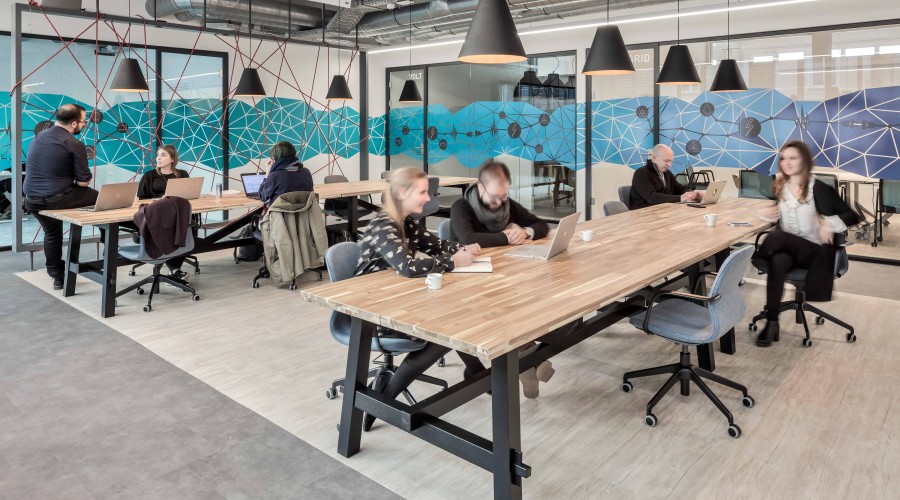
How to maintain temperature, humidity and indoor climate in the office?

Workplace health and safety is all about managing risks in a way that protects both your employees and your company. Indeed, organizations that prioritize health and safety tend to be more productive, according to research. Reduced downtime due to illness and accidents also leads to fewer interruption and cost savings for companies. Therefore, it is definitely worth it to invest in a healthy environment in the office.
Various factors play a role in creating a pleasant indoor climate and have an influence over workplace productivity. Consider, for example, the layout of the room, the temperature, the supply of sufficient fresh air and the prevention of draughts. In this blog we will dive deeper into the temperature and the facilities maintaining temperature and indoor climate in the office.
How warm can it be in the office?
The ideal temperature in the office differs from employee to employee, the Occupational Health and Safety Act (Arbo in the Netherlands) recommends discussing with employees an ideal temperature that at least 90% of the people feel comfortable with.
The best suitable temperature in the office is around 22 degrees. For simple physical office work, the maximum temperature in the office is 28 °C. During the winter it can be a bit colder than in the summer. A temperature that is too low is inconvenient, but a temperature that is too high can in some cases be downright dangerous. Think about employees who have cardiovascular problems or pregnant women. So take a good temperature in the office seriously.
Maximum temperature for the workplace or office
General rules apply to working in offices and small workspaces to determine whether the temperature is too high for the work to be performed. This is an indication and not a legal limitation.
- In the summer, the ideal temperature in the office is between 23 °C and 26 °C.
- Temperatures above 26 °C result in additional physical strain and the employer must consider measures.
- For simple physical office work, a maximum of 28 °C applies in the office.
- For intensive, physically strenuous work, the maximum of 26 °C applies. Provided that there is a clearly perceptible air flow. It should not be warmer than 25˚C without a noticeable airflow.
- For very physically strenuous work, a maximum of 25 °C applies, provided there is a noticeable airflow. Otherwise, it should not be warmer than 23 °C.
Office space that is too warm
Several studies have shown that people's productivity decreases when it is hotter than 25 degrees Celsius in an office. The body overheats and concentration decreases. The loss of productivity can be as high as 30 to even 50%. Substantial numbers, therefore, important to pay attention to it. Although these temperatures are not common in the Netherlands, it is important for companies to take precautions. For example:
- Ensure window shading on hot days
- A good air conditioning or climate control system
- Installing fans to provide a pleasant breeze
- Temporarily turning off unused appliances that give off heat
Are you looking for an office space with air conditioning? Contact our office space specialist or use the filters on flexas.com when searching online for an office space.
Office that is too cold
Just like an office that is too warm, an office that is too cold is also not advisable when it comes to an optimal working environment. If the temperature is too chilly, employees suffer from stiff limbs such as their fingers, for example, which is especially inconvenient for office work. Work at the computer will be slower and slower as a result. A few tips to prevent these problems:
- Discuss with employees what is an acceptable temperature for everyone
- Consider underfloor heating when (future) laying a new floor; this ensures constant and effective heat distribution
- Make sure the central heating is solid and works properly.
- Provide electric foot heaters if necessary
- Ensure good air humidity. Cold air contains little moisture, which can cause employees to suffer from dry-air complaints.
How can I influence the temperature in my workplace?
Improving office temperature conditions begins by gaining an understanding of the existing conditions and by collecting employees' personal preferences regarding the thermal environment in order to decide how it may be improved. Inhabitant self-reports and comfort assessments based on human physiological reactions are the two major methods for achieving this measurement.
The building temperature can then be established using these algorithms, and human data by using an HVAC control framework. Moreover, rapid adjustments can be made using individual sensors that monitor not only temperature but also other critical indicators outlined by the HSE, such as humidity and CO2 levels. Such sensors may be connected to walls, ceilings, doors, windows, or machinery and are known as smart sensors.
Other technologies exist to control room temperature, the following tools can be helpful:
- Climate control system
- Air conditioning
- Ventilation
- Heating
- Humidifiers / dehumidifiers
Nevertheless, the best solution for a good indoor climate in the office remains a climate control system. With such a system you have much more control over the indoor climate than, for example, an air conditioning system. There are several companies that focus specifically on this and can give you excellent advice and help you achieve a perfect indoor climate.
Improve the indoor climate at the office
What is a good indoor climate? An indoor climate is excellent when the temperature is between 21 and 23 degrees on hot days and when the air humidity is between 40-60%. In case of particularly high heat, it is wise if the temperature inside is also higher. Then the difference between inside and outside is not too big. An office building where many people sit and which is poorly ventilated will give health problems and influences work performance. A poor indoor climate in the office is mainly due to poor ventilation in the office building.
What to do about bad ventilation?
There are several things to do when your office building has a bad ventilation:
- When the weather allows, open windows and doors and use a fan to circulate stagnant air.
- Air quality may be improved by removing pollutants from the air. One way to cleanse the air is to use a diffuser to infuse indoor air with an essential oil that has antibacterial or purification qualities.
- Air purifiers with HEPA filters are very effective in removing pollutants from the air. The majority of air purifiers remove particulate matter but not gases or other pollutants.
- Invest in air purifying office plants. Plants are used as nature's air cleansers, because they can absorb pollutants from the air. Keep in mind that mold thrives in areas where plants are frequently watered, so keep an eye out for it and wipe it up as needed.
Office humidity and air exchange
Not only temperature influences the health and safety of employees, also pay attention to the air humidity. The evaporation of air produces a lot of heat and that is unfavourable for the indoor climate. A humidity level between 40 and 60 percent is ideal and a humidity level between 30 and 70 percent is really necessary. Is the humidity above 70 percent for a longer period of time? Then this can result in mold and also harm employees.
CO2, humidity and temperature are the cornerstones of a good indoor climate in the office. With cold days the windows often stay closed and the heating goes on. This affects the indoor climate in the office. In offices it is recommended to have a minimum air exchange rate of 30 m³/hr per person.
To prevent mold and keep an good air humidity in the office there are several things that can help:
- Install an efficient ventilation system.
- Change dust filters in the ventilation system regularly and clean the ducts.
- Place printers, faxes and copiers that produce more than 5,000 copies per month in a separate room with adequate ventilation.
In addition to air exchange, it is also important to clean the workplace regularly. A clean workplace improves air quality. Therefore, take the following measures:
- Make sure the workstation is cleaned regularly.
- Keep the desk as empty as possible (clean desk policy) so that dust can be removed.
- Use closed cabinets.
- Use smooth floor coverings that are easy to clean.
Pay attention to temperature, ventilation and humidity
The environment of the office, as well as employees’ occupational health and safety, all contribute to a healthy workplace environment. Therefore, elements such as temperature, ventilation and humidity should be taken into consideration and examined in order to create a comfortable workspace. Hence, you also have to pay attention to this elements when renting an office. Effective air conditioning systems and a climate control systems are necessary to ensure thermal comfort and maintaining temperature management.
Do you need help with renting an office space? And do you want to include a climate control system or airconditioning system? Our office space specialist are well aware of the important temperature maintaining facilities in offices. Don't hesitate to contact us by chat, phone or e-mail to get more insights about an office space.


